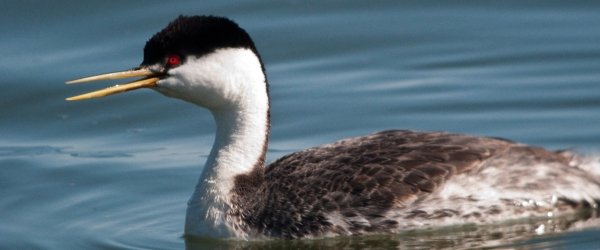Western Grebes (Aechmophorus occidentalis) and Clark’s Grebes (Aechmophorus clarkii) are probably best known for their elaborate courtship displays. These ceremonies are some of the most complex displays in the world of birds.
We are fortunate in Northern California to have four lakes that support 76% of the total number of nesting grebes in California1. Back on the first weekend in May, I attended the Heron Festival at Clear Lake, one of the four aforementioned lakes which also include Eagle Lake, Lake Almanor and the Thermalito Afterbay of Lake Oroville. Eagle Lake, Lake Almanor and Clear Lake have all been identified as Audubon California Important Bird Areas (IBA), meaning that they provide essential habitat for breeding, wintering, and migrating birds.
Sure, the Heron Festival had some great birding opportunities like the pontoon boat trip on the lake to see the Great Blue Heron rookery, several Osprey nests and even a Green Heron nesting in one of the inlets. The boat trip also offered some good looks at the Yellow-headed Blackbirds nesting along the shores.
But the real reason I went to the festival was to see the Clark’s and Western Grebes exhibiting their mating rituals. The Western Grebe can be distinguished from the Clark’s by its yellowish green bill and the black of the crown extending below the eye.
You can see a photo of the Clark’s Grebe on my friend Hearman’s Flickr page. Note the eye completely surrounded by white, including white lores, and the bright orange bill.
I didn’t see any Clark’s Grebes this day but they do breed at Clear Lake and they exhibit the same courtship displays as the Western Grebe.
Like the breeding activity of many species this spring, the grebes were late, probably due to the unseasonable weather. I was only able to see some of their courtship rituals. This pair is engaged in a “greeting ceremony.”
Note the raised crests as the female (on the left) turns to face the larger male (on the right).
As they swim along next to each other, the male does a quick “Bob-preening,” running his bill through his scapular feathers…
then returns to the “high arch” position…
as they swim off into the sunset.
I found another pair a bit later that afternoon engaged in the “Weed Ceremony.2” These two Western Grebes have just come up from a dive, each with a piece of organic material in their beaks.
As they come together, with their feet churning, they rise into a vertical posture with most of their bodies out of the water.
They move forward together in this position until one of the pair discards the weed with a quick head shake.
I thought at this point the two were going to go into the “Rush Ceremony” where they rise up out of the water and run across the surface, side by side, ending with a dive into the water. Instead, they slowly paddled away together.
I have learned today that the grebes at Eagle Lake are currently exhibiting the courtship behaviors and I hope to get up there this weekend to witness the full blown version. Until then, I have found a beautiful video by the BBC showing the entire ceremony. Enjoy!
httpv://www.youtube.com/watch?v=v1XAFo_uVgk
References: 1 Audubon California; 2 Birds of North America Online

























They are so interesting to watch. I spent hours on Alamo Lake, AZ watching and photographing. When I was there I found most of their antics were before sunrise which made for difficult photography of moving birds. Nice job Larry.
Very elegant birds, and great shots by the way!
how beautiful. how could you not fall in love all over again…
Wonderful pictures and great post. I’ve seen some small portion of this display in southern California but never this much. Some day…
Absolutely amazing capture. They mate for life? Are these birds hunted at all? Thank you for sharing Larry!!
@Susan from the early 1890s until approximately 1906, tens of thousands were shot for their “fur,” the silky, white, ventral plumage which was used to make capes, coats, and hats. Thank God they are now protected by the Migratory Bird Treaty Act.
You may be surprised at the birds that are on the U.S. Fish and Wildlife Service list of Game Birds and Hunted Species however.